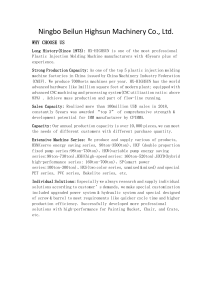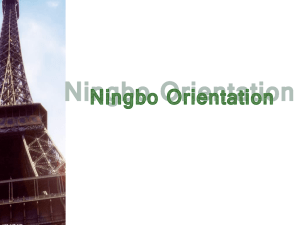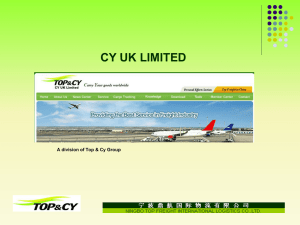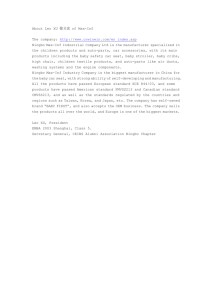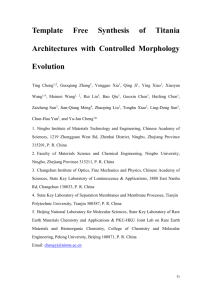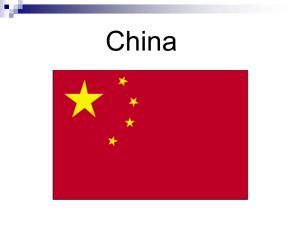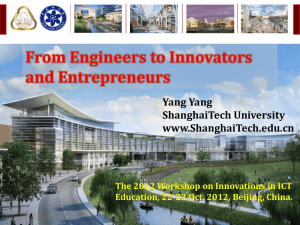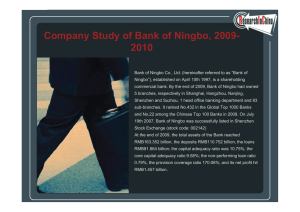China's Technological Capability
advertisement
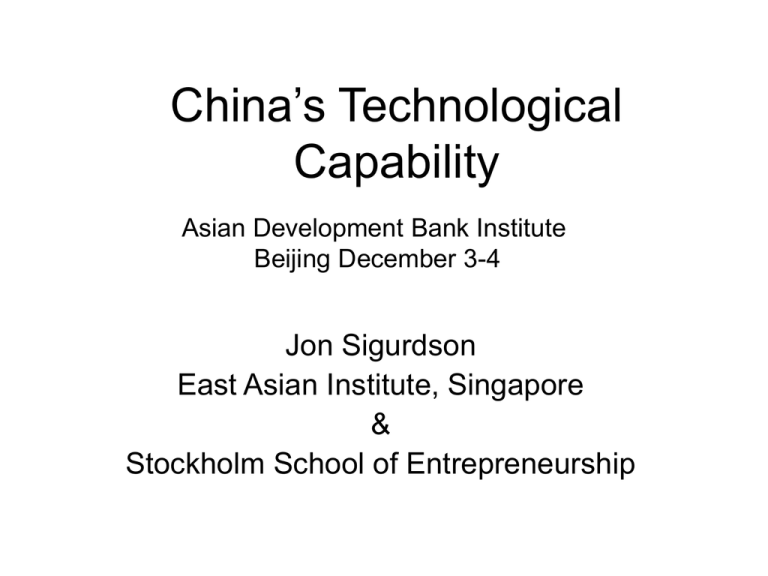
China’s Technological Capability Asian Development Bank Institute Beijing December 3-4 Jon Sigurdson East Asian Institute, Singapore & Stockholm School of Entrepreneurship Textile Industry A • US and EU companies currently buy from about 60 countries - might source from as few as 20 by 2006 and less than 10 by 2010. • China might capture some 50 per cent of the trade compared with presently 16 per cent. • Many Chinese companies are already offering improved supply-chain management and valueadded services in design Textile Industry B • The average Chinese garment worker was paid $1,600 in 2001, more than double his Indian counterpart • Despite the Chinese worker’s higher pay productivity was significantly higher: he adds $5,000 a year in value to the garments he processes, compared with $2,600 by his Indian equivalent. • The difference reflects China’s greater investment in modern manufacturing equipment and in infrastructure such as transportation. Industrial Categories - Lall • • • • Resource-based industries Low-technology industries Medium-technology industries High-technology industries R&D share of GDP 1998-2003 1.4 1.2 1 0.8 0.6 0.4 0.2 0 1998 1999 2000 2001 2002 2003 Three Goals of China's Science and Technology • China aims to be one of the frontrunners among developing countries around 2010, to the medium level among world giants in science and technology 11 years later – 2020 - and squeeze into the top rankings among those giants around 2049 Source: Bai Chunli, Vice President of the Chinese Academy of Sciences People’s Daily, November 26 2004 China’s First S&T Strategy • Make full use of the global innovative resources • participate widely in bilateral, multilateral and global competition and cooperation • enhance China's capability in innovation and industrialization level in science and technology. China’s Second S&T Strategy • boost the foundation and vigor of science and technology • improve foresight at the frontiers of basic research and important hi-tech fields • enhance original scientific innovation; • prioritize information, life, material sciences and important interdisciplinary sciences • realize breakthrough and leap forward in selected key technologies where China has a competitive advantage. China’s Third S&T Strategy • exert special efforts to solve problems affecting the development of science and technology. • strengthen the construction of the national innovation system • Strengthen reform on marketization • promote the close combination of science and technology, with economic and social development - also with national security • Reform and develop the educational system China’s Changing Universities • • • • 1990-95 Xiahai – Go into business 1995-2000 Consolidation 2000-2005 Expansion 2005-2010 Upgrading quality Critical Mass in Technology? • By 2014, which is 10 years away, the number of college graduates in China could reach 80 million. • At this point China could achieve sufficient critical mass to pose a strong challenge to its neighbours - the Japanese and South Koreans - in technological development. • Let us assume that 20 million Chinese graduates in 2013 have engineering training and, among them, 1% are engaged in research on high-tech marketable products • China would then have around 200,000 brains pushing that frontier All Students in Population - % University Students/1,000 25 Students: Population % University Students 20 15 10 5 19 78 19 80 19 85 19 89 19 90 19 91 19 92 19 93 19 94 19 95 19 96 19 97 19 98 19 99 20 00 20 01 20 02 0 in g ng in ee r nc e A gr ic ul tu re M ed ic in M e an ag em en t E S ci e is to ry H n Li te ra tu re tio du ca E La w hi lo so ph y E co no m ic s P University Enrolment - Fields of Study 2003 x1,000 4000 3500 3000 2500 2000 1500 1000 500 0 an a re en t ci ne ge m ed i ul tu 2003 er in g e ry 2000 M to 2002 Ag ric gi ne n re ie nc Hi s te ra tu io w 2500 M La ic s ph y uc at Sc Li En so on om ilo Ed Ec Ph University Enrolment - Fields of Study 2002-2003 x1,000 4000 3500 3000 1500 1000 500 0 Graduate Studies - Total and New Enrolment 1978-2002 x1,000 600 500 Graduate Enrollment 400 New Graduate Enrollment 300 200 100 20 01 19 99 19 97 19 95 19 93 19 91 19 89 19 87 19 85 19 78 0 Challenging Factors - Moreira • Endowment • Productivity • Scale • Government suppport Technology upgrading and frontier development China’s Position in Selected Sectors • • • • • The IT sector Integrated Circuits High-performance computers Aircraft Other sectors, e.g. biotechnology Integrated Circuits • Domestic demand: memories. ASICs etc. for global IT products • Earlier: almost total imports • Domestic supply: • - Taiwan companies: SMIC • - Intel & Infineon&Motorola & Matsushita, etc. • - Chinese companies started to produce advanced processor chips: Arca, Longxin High-performance Computers • China is in late 2004 in possession of 14 supercomputers out of a total of 500 which gives China a fourth ranking in the world on level of Germany and only behind the US, Japan and Great Britain. • The Shanghai Supercomputer Center in June 2004 assembled a machine that at the time became the world’s 10th fastest computer, by using more than 2,500 chips designed and manufactured by Advanced Micro Devices in the US Supercomputer companies • Lenovo (formerly Legend) spun-off from the Institute of Computing Technology (ICT) in 1981 and entered the HPC market in 2001. ICT is one of major research institute of the Chinese Academy of Sciences • Dawning that was spun-off from ICT in 1995 and the same year entered the HPC market. Development jointly with ICT and the Shanghai Supercomputer Center. • Langchao entered the HPC market in 2002 • Galactic Computing become the recent entrant in the computer industry in 2004 China’s Aircraft Industry ”Aviation Industries of China” • CAICI – regional jet domestic development – ARJ21 • CAICII - regional jet joint venture with Embraer – EMB170 • Boeing and Airbus - subcontractors • civil aviation fleet would have to add 1,400 large jet liners by the year 2022, which if all are imported, as in the past, would cost in the region of US$100 billion • aviation industry executive declared in March 2004 that he anticipates China's first large aircraft to fly by 2018 China’s Path Towards TechnoPower Labor intensive Industries FDI Exploiting ”floaters” Moving inland High.tech Brainpower Knowledge infra-structure Nano, bio, new materials FDI Engineers Technology IPR Industry Labour-intensive R&D Investment Talents Young University graduates Universities Incubators Industrial Parks Science Parks Heterogenity - Devlin • • • • • • Shanghai Ningbo .. .. Dongguan, Guangdong .. Ningbo – Moulding Industry • Metal molding already strong is expanding into new product areas, attracting investments from Hong Kong. • There are three molding industry centers in China. One is Shenzhen which has its focus on die-casting for electronics. The second one is Taichu in Zhejiang that is strong in plastics. The third center is Ningbo which has become strong in molding for the automobile sector and for home electric appliances. Ningbo – Moulding cluster • • • Molding industry employs some 100,000 workers. 1. Expansion in Shanghai forcing an industrial restructuring in Ningbo. 2. Private industry has played a pivotal role. 3. Expanding demand from Japan, Germany and Taiwan has fostered a local development of the molding industry 4. Machinery for plastics molding developed at early stage. Ningbo enterprises deliver molds for products that weigh only a few grams to pieces as large as 50 kilograms Subsidiaries in the US, and companies from Korea and Japan have made investments in Ningbo. 1. Operational clusters Proximity gives speed of throughput, product changeovers, increasingly specialized engineering and assembly labor. Operational clusters may on occasion be sources of new product ideas, but their principal goal is to achieve operational efficiencies Any new technologies they create are meant to improve production processes of supply chain management 2. Technological clusters Technological clusters offer co-location of activities that lead to the recognition of new market opportunities, the development of new technologies and the design of new products. Such cluster change over time as new firms enter into the technological field and new designs offer or demand major changes in global production networks. Flying Geese over China – Advancing Technology Inland – Western Northeast Costal Areas
